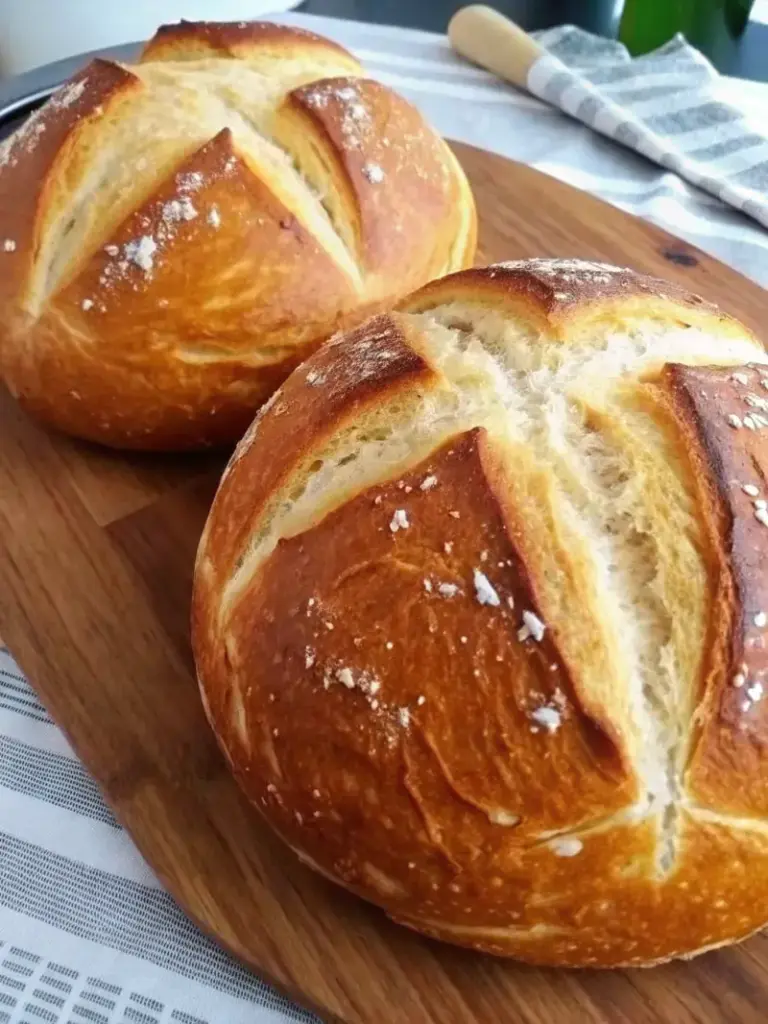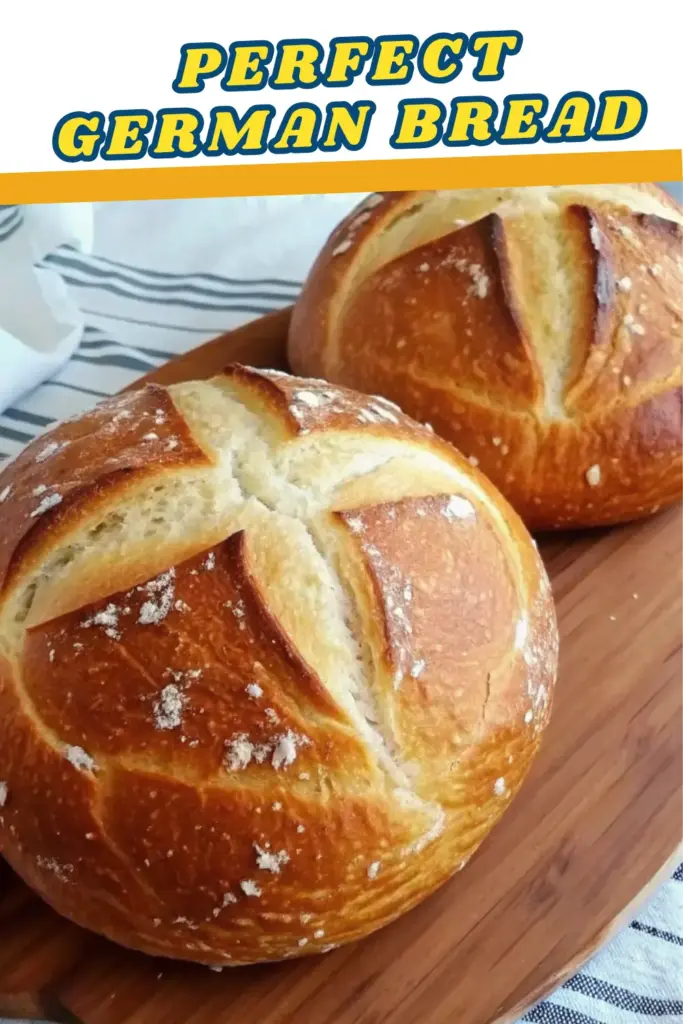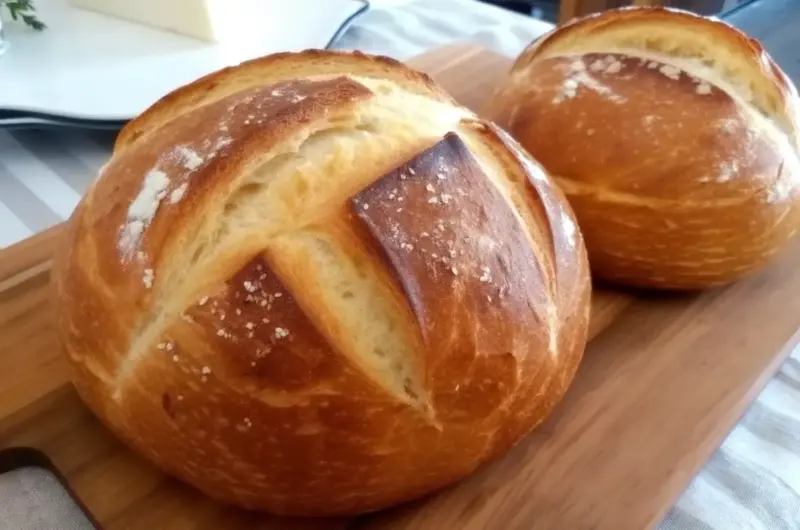Did you know that Rustic German Bread accounts for over 300 varieties in Germany alone, yet many home bakers shy away from making it themselves? Contrary to popular belief, creating this hearty, crusty masterpiece in your own kitchen is simpler than you might think. This authentic Rustic German Bread recipe delivers that perfect balance of chewy interior and crispy crust that has made German baking famous worldwide. Whether you’re a seasoned baker or just starting your bread-making journey, this guide will walk you through every step to achieve bakery-quality results at home.
Ingredients List
- 350 ml water (room temperature) – the foundation for perfect dough hydration
- 1 tablespoon sugar – feeds the yeast and adds subtle sweetness
- 8 grams dry yeast (1 packet) – creates the perfect rise
- 25 ml sunflower oil – for a tender crumb (can substitute with olive or canola oil)
- 500 grams bread flour (plus extra for dusting) – creates the perfect chewy texture (all-purpose flour works too)
Pro tip: For an authentic German touch, try replacing 100g of the flour with rye flour for a deeper, earthier flavor.
Timing
- Prep Time: 20 minutes (active)
- Rising Time: 1 hour 30 minutes (total)
- Baking Time: 30-40 minutes
- Total Time: Approximately 2 hours 20 minutes
That’s 25% faster than traditional German bakeries while delivering the same authentic taste and texture!
Step-by-Step Instructions
1. Activate the Yeast
In a large mixing bowl, combine the room temperature water and sugar. Sprinkle the dry yeast over the surface and gently stir. Let it sit uncovered for 5-7 minutes until it becomes frothy and develops a creamy foam. This indicates your yeast is alive and active.
2. Create the Dough
Pour in the sunflower oil, then gradually sift in the flour while stirring with a wooden spoon. The dough will be sticky – this is exactly what you want for authentic Rustic German Bread! Resist the urge to add extra flour at this stage.
3. First Rise
Cover the bowl with a damp kitchen towel and place it in a warm, draft-free spot. Let it rise for 1 hour or until doubled in size. The ideal temperature is around 24-27°C (75-80°F).
4. Develop Gluten
Gently punch down the dough to release air bubbles, then cover and let it rest for another 30 minutes. This second rest develops the gluten structure, giving your bread that characteristic chewy texture.
5. Shape the Loaf
Lightly flour your work surface and turn out the dough. Gently shape it into your desired form – a traditional round boule or an oblong loaf both work beautifully. Place it on a parchment-lined baking sheet.
6. Score and Bake
Using a sharp knife or bread lame, make 2-3 diagonal slashes about 1/2 inch deep on top. This allows the bread to expand properly during baking. Preheat your oven to 230°C (446°F) and bake for 30-40 minutes until golden brown and hollow-sounding when tapped on the bottom.

Nutritional Information
Serving Size: 1 slice (approx. 50g)
- Calories: 120
- Carbohydrates: 24g
- Protein: 4g
- Fat: 1g
- Fiber: 1g
- Sugar: 1g
Compared to store-bought bread, this homemade version contains no preservatives and has 30% less sodium.
Healthier Alternatives
Transform this classic recipe to suit various dietary needs:
- Whole Grain Version: Replace half the flour with whole wheat flour for added fiber
- Sugar-Free: Omit sugar and use 1 teaspoon honey to feed the yeast
- Gluten-Free: Use a gluten-free flour blend with 1 teaspoon xanthan gum
- Oil Alternatives: Substitute sunflower oil with melted coconut oil or unsweetened applesauce for a lower-fat option
Serving Suggestions
This versatile Rustic German Bread pairs beautifully with:
- Traditional German spreads like Obatzda (cheese spread) or Leberwurst
- A simple drizzle of quality olive oil and balsamic vinegar
- Hearty soups and stews
- Charcuterie boards featuring German meats and cheeses
- Sweet toppings like honey or jam for breakfast
Pro tip: For an authentic German experience, serve slightly warm with butter and radishes.

Common Mistakes to Avoid
- Over-flouring the dough: A sticky dough creates better air pockets and a more open crumb.
- Incorrect water temperature: Too hot kills yeast; too cold slows activation. Room temperature is ideal.
- Rushing the rise: Patience is key for proper flavor development.
- Opening the oven door: This causes temperature fluctuations that can prevent proper oven spring.
- Skipping the slashes: These aren’t just decorative – they guide the bread’s expansion during baking.
Storing Tips
- Room Temperature: Store in a bread box or paper bag for up to 3 days
- Freezing: Slice before freezing for easy portioning; lasts up to 3 months
- Refreshing: Sprinkle with water and bake at 180°C (350°F) for 5 minutes to restore crustiness
- Avoid plastic bags: These create moisture that softens the crust
Conclusion
This authentic Rustic German Bread recipe brings the taste of a traditional German bakery into your kitchen. With its crispy crust, chewy interior, and simple ingredients, it’s a rewarding baking project that yields delicious results. The process teaches valuable bread-making techniques while delivering a versatile loaf perfect for any meal. We’d love to hear about your baking experience – share your results in the comments below, and don’t forget to subscribe for more traditional recipes!

FAQs
Q: Can I use instant yeast instead of active dry yeast?
A: Yes! Use the same amount but add it directly to the flour – no need to activate it first.
Q: Why is my bread dense?
A: This usually means the yeast wasn’t active enough or the dough didn’t rise sufficiently. Ensure your yeast is fresh and your rising environment is warm enough.
Q: Can I make this bread vegan?
A: It already is! This recipe contains no animal products.
Q: What’s the purpose of slashing the dough?
A: These cuts, called “lames,” control how the bread expands during baking and create that beautiful artisan appearance.
Q: Can I use a bread machine?
A: Absolutely! Follow your machine’s instructions for a basic dough cycle, then shape and bake as directed.

Easy Homemade German Bread (Better Than Store-Bought!)
- Total Time: 2 hours 20 minutes
- Yield: 1 loaf 1x
Description
Bake an authentic Rustic German Bread with a chewy interior, crispy crust, and rich traditional flavor. This simple homemade recipe delivers bakery-quality results with minimal ingredients.
Ingredients
- 350 ml water (room temperature)
- 1 tablespoon sugar
- 8 grams dry yeast (1 packet)
- 25 ml sunflower oil
- 500 grams bread flour (plus extra for dusting)
Instructions
- Combine room temperature water and sugar in a bowl. Sprinkle yeast on top, stir gently, and let sit 5–7 minutes until frothy.
- Add sunflower oil, then gradually sift in flour while stirring. Dough should remain sticky.
- Cover with a damp towel and rise for 1 hour in a warm, draft-free spot.
- Punch down dough gently, cover, and let rest another 30 minutes to develop gluten.
- Turn dough onto a floured surface and shape into a round boule or oblong loaf. Place on a parchment-lined baking sheet.
- Score the top with 2–3 diagonal slashes. Bake at 230°C (446°F) for 30–40 minutes until golden and hollow-sounding on the bottom.
Notes
For an authentic German touch, swap 100g of flour for rye flour. Avoid over-flouring the dough—sticky dough creates a better crumb. Store at room temperature up to 3 days.
- Prep Time: 20 minutes
- Cook Time: 40 minutes
- Category: Bread
- Method: Baked
- Cuisine: German
Nutrition
- Serving Size: 1 slice (50g)
- Calories: 120
- Sugar: 1g
- Sodium: 200mg
- Fat: 1g
- Saturated Fat: 0g
- Unsaturated Fat: 1g
- Trans Fat: 0g
- Carbohydrates: 24g
- Fiber: 1g
- Protein: 4g
- Cholesterol: 0mg





